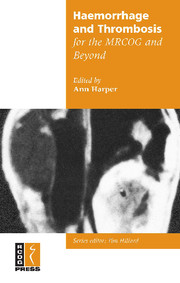
- Publisher:
- Cambridge University Press
- Online publication date:
- October 2014
- Print publication year:
- 2005
- Online ISBN:
- 9781139924498

Although disorders of the coagulation system are uncommon in pregnancy, the two main hazards - haemorrhage and thromboembolism - are leading causes of direct maternal death in the UK and worldwide. Gynaecologists may encounter abnormal haemostasis as a cause of intractable menorrhagia or perioperative haemorrhage, and thromboembolism is a significant risk for women undergoing major gynaecological surgery. This book brings together various aspects of haemostasis in relation to obstetrics and gynaecology to provide practical guidance to clinicians, who may only occasionally encounter these problems. Emphasis is placed on the need for good working relationships and close liaison between obstetricians and gynaecologists, anaesthetists, haematologists and blood transfusion services. The book is primarily designed to provide a comprehensive summary for candidates preparing for the Part 2 MRCOG examination, and as such covers the RCOG curriculum for haemorrhage and thrombosis. It is also a valuable guide for all healthcare professionals working in the field.
 Loading metrics...
Loading metrics...
* Views captured on Cambridge Core between #date#. This data will be updated every 24 hours.
Usage data cannot currently be displayed.